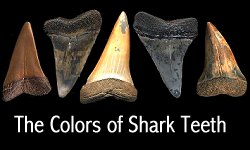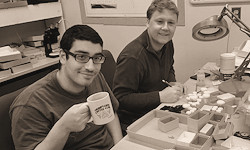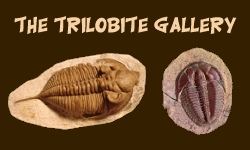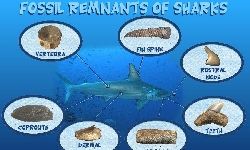Calvert Cliff articulated dolphin skeleton quarried

This image shows the "smear line" in the Calvert Cliffs where the fossil bones, fairly articulated, were strewn along. You can see the line is quite long.
Calvert Cliff articulated dolphin skeleton quarried
Article posted in the February 2002 edition of the Rostrum published by the Maryland Geological Society By Paul R. Murdoch Jr.
After appearing in the MGS newsletter, the story was nominated for and won the MGS's article of the year award. It was then forwarded from the MGS by it's editor, Mr. Robert Asreen (Thanks Bob!), to the American Federation of Mineralogical Societies for consideration for it's Editors Award National Competition, specifically in the Original Adult Article category. At the group's annual convention in California this past June it won first place!
It also won another award in October 2003. The Eastern Federation of Mineralogiocal and Lapidary Societies gave the article the Trophy Award (top honors) for the Featured Articles category in their Annual Editors Awards contest!
Over the course of several days in October the Calvert Marine Museum excavated, from zone 13 of the Calvert formation along the Western shores of the Chesapeake Bay, what has been preliminarily identified as a juvenile specimen of the Miocene porpoise Eurhinodelphis bossi. This specimen is rumored to have been eroding out of the cliff for the last 2 years, yet was only recently brought to the attention of the museum. The following is it's story
In late May and early June 2001 the CMM was in the same immediate area excavating a baleen whale (probably juvenile, species yet undetermined). The group was informed by long time CMM volunteer Pam Platt that a string of several vertebras, most likely lumbar and/or tail, had been brought to her attention by another fossil hunter, and was eroding out of the cliffs south of the whale site. The group decided to take a look at them the following day to see if enough of the animal was present to warrant an attempt at extracting them. However, on the following morning's walk down from the whale site to the vertebras, Pam met us on the way and informed the group that, overnight, some person or persons had hacked into the vertebras destroying and/or removing all previously visible pieces of the specimen. This made the journey moot and no one bothered to investigate it further and we all returned to a very productive whale excavation. That find may become a working display at the CMM at some point in the first quarter 2002. It was shortly thereafter that I decided to keep an eye on the spot whenever I could get to it and see if more of the find would later erode out over time.
The next time that I was able to access the site was in late September. I brought a friend with me who had, as a child, dreamed of becoming a paleontologist, and this was his first-ever fossil trip. We were both in for a pleasant surprise... after nearly walking right past the spot, we could both clearly see that the find had in fact expanded. The left scapula, several ribs and multiple vertebras with detached epiphysis were now viewable. Imagine being lucky enough to view such a sight on your first ever fossil outing! What a lucky man my friend is. I contacted the CMM and arranged to meet Stephen Godfrey over Labor Day weekend to show him the exact location. In that short span of time hackers again damaged the specimen and several vertebra and epiphysis were missing in the week between calling the CMM and being able to show them the find. Due to scheduling conflicts and the liability concerns of the property owner the dig did not proceed until October. Yet again, during this "down time" the site was vandalized. This time the CMM excavation sign was removed and arrows pointing to the exposed bones in the cliff were carved into the cliff with, apparently, a screwdriver. All of this was discouraging, especially the actions of the thoughtless clod(s) responsible for these acts; acts that put all fossil collectors in a poor light. But the find would turn out to be well worth the wait.

This is a close up of the damaged lumbar vertebrae. There were two other vertebrae visible before they were taken. Also notice the damage marks left by a screwdriver, which was apparently used to pry out the vertebrae. Luckily the skull was safe from damage. If you see a fossil in the cliffs, leave it be, and contact the museum. It is illegal to dig ANYTHING out of the cliffs
Digging finally proceeded in October and the specimen was indeed fairly well articulated with the body facing south. Thankfully little more had eroded out but someone did damage one new piece that had become viewable in the interim. After 2 days of quarrying, the skull was spotted a foot back into the cliff. It had spun around, facing back towards the body at approximately a 60-degree angle with the snout extending back into the cliffs. With this great news in hand, my friend and I were able to get some time off from work to assist in the excavation. We were able to spend the better part of two days helping to extract one jacket containing the left scapula, several ribs and multiple vertebras with detached epiphysis. Working with plaster is such fun!! I used my boat to transport it for a final time over the waters of the Chesapeake Bay up to the awaiting CMM vehicle. What a thrill and it sure beat carrying it!!! This jacket was nearly 4 feet in length and weighed close to 150 lbs. I was unable to spend any additional time assisting with the remainder of the dig but in a few days the second jacket was removed containing the skull, several possible cervical vertebra and both jaws! The both appear to be complete and the upper jaw extended nearly four feet in length!!! Several teeth were found in situ in very close proximity to the skull, but none were viewable intact in either the upper or lower jaws. This jacket was nearly five feet in length and weighed over 170 lbs.

A closeup of the excavation. For scale, the sign is the size of an 8x11" piece of paper. The holes below the jackets are slots dug out for footholds, so they could climb up to the porpoise. The jacket on the left contains the skull, which runs straight into the cliffside, and some vertebrae and ribs. The jacket on the right contains additional vertebrae, a scapula, and some ribs.
The find itself was in great shape and no signs of predation were readily apparent. The only shark material found while excavating was a small (.35 inch) shark vertebra. It was found while pedestalling the jacket containing the scapula and was found approximately three inches underneath the bone layer, and therefore, most likely is not associated to the find. The skull jacket is currently in the prep lab of the CMM. So far the following have been exposed from that jacket: both jaws and the back of the skull, a juggal bone, 6 ribs (including the first rib), a humerus, 3 vertebra (2 are cervical), 16+ teeth not including one still present in the lower jaw and several epiphysis. The skull is believed to be completely intact, but only time and patience will tell. It will take several more weeks until it's true condition is known. The other jacket is in storage, tightly wrapped in plastic to prevent drying and will most likely follow shortly. The excavation also found some additional smaller yet mature dolphin vertebras in the vicinity and several collectors have suggested that a small whale may have eroded out from the same spot as well over the past two years.
After the find began being prepped, several of the epiphysis that were removed from the specimen by collector(s) over these several months were donated to the CMM. I, as I'm sure are many others, am happy to see that these pieces have been reunited and hope that more of what was removed will make their way to the museum, but am upset that they were removed in the first place. We all must remember that if permission is not granted by a landowner we have no right to dig or trespass on private property no matter how tempting a find or location might be. If you do spot a notable find in situ, don't dig it out! Instead, one should contact a local museum; e.g. CMM, VMNH or NMNH. You will be given full credit for the discovery and most likely will be allowed to participate in the excavation. In this case, the skull is in such fine condition that it may, at some point, become a permanent display at the CMM, but it's still to early to tell.
I personally consider these events to represent the whole spectrum of fossil collecting and collectors. We have the good, the bad and the ugly out there, but I chalk this one up as a big group win even considering the actions of a thoughtless few. I just happened to be the one who followed up on the find and made sure it was brought to the museum's attention. Several people not only assisted in the excavation of the find, but also in making sure it was known to the museum, and therefore feel a special connection to the find. I hope it brings all involved a great deal of personal satisfaction to be able to say one day: "See that there, I had a part to play in it getting here so that everyone can enjoy it". To those of you who helped along the way, Thanks!!! It really is a fine specimen.
Go down to the CMM and check it out for yourself, it's worth the trip!

This side of the jacket looks about ready! The little bone on the cardboard is a juggal bone. They are very fragile, and are usually not found. Notice the natural crack disrupts the fossil. At least crack did not go straight through the skull!
Additional Images of the Eurhinodelphis Dolphin Excavation from the Calvert Cliffs of Maryland
Please note, digging in the Calvert cliffs is illegal. This fossil Eurhinodelphis was dug out with permission by the Calvert Marine Museum.

Here is another shot of the fossil eurhinodelphis vertebrae, ribs, and scapula. The dark stuff on the scapula is paleobond.

In this final image, one can see a Eurhinodelphis rib and scapula (treated with paleobond) sticking out of the cliff.

This shows an overview of the fossil Eurhinodelphis dig site. Luckily it was quite a nice day.

Stephen working on the fossil Eurhinodelphis skull jacket.

Here is Paul plastering up the fossil Eurhinodelphis jackets!

This is a chunk that contains the eurhinodelphis skull. Stephen is pointing out that the fossil skull runs straight into the cliffside.

This pic shows a natural crack in the skull jacket. Hopefully this crack did not damage the Eurhinodelphis fossils too much.

Here is the skull jacket about to be lowered out of the hole. Quite a task, since the fossil jacket is so large and high up in the cliff.

Once the fossil jacket is removed it will be placed in the small boat and be taken to the CMM. Hopefully the large jackets will not sink the tiny boat!!

Finished! All that's left is a giant hole!
Preparation of the Eurhinodelphis:

This is the skull jacket in its initial stages of preparation. Notice how beautifully preserved the lower jaw is. The second jacket will be prepped after this one is finished.

Here you can see the a complete rib exposed against the snout. Also, the upper mandible is begging to be uncovered (the skull is upside down).

Besides being a mug shot for Paul, this image shows the upper Eurhinodelphis mandable once it became completely exposed. Notice how long it is; hence the name "long-snouted dolphin."

This is a closer view of the exposed mandables.

Once the mandables have been completed, work begins on the rest of the skull and the misc bones strewn about in the jacket

This is a close up of the upside down Eurhinodelphis skull about to be prepped.

The preparation of the fossil eurhinodelphis is comming along nicely! Notice all of the vertebrae and ribs strewn about. I can't wait to see what's in the second jacket.

This side of the jacket looks about ready! The little bone on the cardboard is a juggal bone. They are very fragile, and are usually not found. Notice the natural crack disrupts the fossil. At least crack did not go straight through the skull!
Related Content
About the Author
Contact Us
To ask Questions about Paleontology, Fossil Identification, Image Use, or anything else, email us.
Fossilguy.com is very active on Facebook, you can also message us there!
We don't buy or sell fossils, so please don't email us asking about the value of a fossil or fossil purchases.
Visit us on Social Media:
Enjoy this website?
Consider a Paypal / Credit Card donation of any size to help with site maintenance and web hosting fees:
Privacy Policy and Legal Disclaimer
Back to the TOP of page
© 2000 - 2025 : All rights reserved
Fossilguy.com is a participant in the Amazon Services LLC Associates Program, an affiliate advertising program designed to provide a means for sites to earn advertising
fees by advertising and linking to amazon.com









